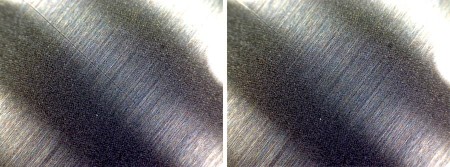That 6 inch size is there to accommodate the 6 inch screen, which looks great from all angles, and even though it curves, is still easy to see. It’s also curved to provide some flex when pressure is applied, and means breakages will be less of an issue, but that’s only one part of the equation, as LG has equipped the G Flex with something we’ve never seen on a phone: elastic polymer paint.
In previous G-class smartphones from LG, we’ve seen printed holographic paint jobs, which sparkle in light, and generally look a little more interesting than the standard black or white most other devices sport.
But in this handset, the sparkling paint job also serves a purpose, and that is to repair the minor nicks and scratches your keys and other things might leave in the back.

The environment you’re in needs to be fairly warm for this to work, and it needs to be acknowledged that it won’t fix every scratch you give the handset. In fact, in the testing we did, only the minor parts of a heavy scratch would be repaired, with the deeper section sticking around for a while.
Still, though, the inclusion of this technology is a cool one, and even though we wish LG would move to a more robust material than plastic for the chassis, this makes up for what we’re seeing, and paired with the plastic screen, makes perfect sense.
To see the full-size image from our microscope, click this link (1MB download).
Using Android on this handset is a mostly pleasant experience, and we’re delighted to see LG is refining its Android overlay nicely. The experience is still relatively stock, with multiple homescreens, widgets, app menus, and a shortcut dock you can change, which is something the Samsung phones in Australia seem to struggle with.
LG has left in things we’ve seen before such as the gallery zoom which can change thumbnail sizes quickly, the drop-down menu system with multiple control shortcuts for different hardware settings, and the ability to quickly change the app menu icon sizes and even the wallpaper for this section.
There’s also a new “Easy Home” homescreen for new Android users that does away with the multiple homescreens and makes the entire phone look easy, with a weather clock up top, shortcuts you can quickly change (hold the icon down), and a big dial pad for making phone calls. You can run all the apps you normally would, and even install more of them, but it just makes everything easier for novice Android users.
LG’s “VoiceMate” also fills a nice gap with voice-activated functionality, but it doesn’t do enough yet. Still, if you want to make calls just by speaking it, simply switch it on and say either “LG Mobile” or even “Hello Genie” (we don’t get this one) at the lock screen. It won’t work on the homescreen when it’s unlocked, but that could be something LG will patch later.
Even the keyboard has been refined slightly, though it still needs work. In the G Flex, the on-screen virtual keyboard is big and clear, but the gesture keyboard still obviously needs work, picking suggestions that don’t remotely seem to make sense much of the time, and making it a chore to delete the suggestion rather than just flat out replacing it.
Symbols and punctuation also seem to appear in the wrong place, and if you expect them to appear after a spacebar, LG’s software will push them back next to the word.
Thankfully, there are loads of software keyboard replacements out there, so if you do end up with the G Flex, it’s not an issue at all to replace this section.

Still, with Qualcomm’s Snapdragon 800 processor on-board, the G Flex flies, producing impressive benchmarks, no slowdowns, and the ability to run multiple applications with ease. If you can find a way to make this phone slow down, you’re doing better than us.
Also excellent in performance is the mobile broadband speed, which tested on the Telstra network, scores between 20 and 70Mbps. Optus is the preferred telco for this handset, and with the 850MHz frequency not supported for phone calls or data, it would be worth seeing if you can use Telstra or Vodafone in your area.
We had no problems with Telstra for either voice, text or data in Sydney, though you may end up having a different result.
Battery life is also decent, and with a massive 3500mAh battery, we found that day of life was easy, though if you use it — and we mean really use it — you can expect to charge it daily.
Most people, though, should be able to manage a day and a half of battery life, with two days possible if the screen time is lessened and you don’t hammer the handset.













One Comment